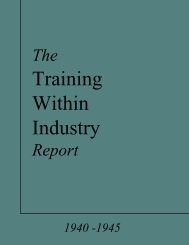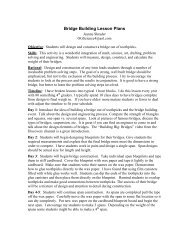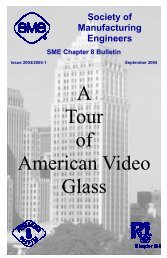Training Within Industry in the United States by Channing R. Dooley
Training Within Industry in the United States by Channing R. Dooley
Training Within Industry in the United States by Channing R. Dooley
You also want an ePaper? Increase the reach of your titles
YUMPU automatically turns print PDFs into web optimized ePapers that Google loves.
TRAINING WL'CHIN INOUS'L'RY IN TIIE UNITED STATGS 167<br />
Government arsenals and navy yards to g;et 350 properly qualified<br />
lens gr<strong>in</strong>ders. It was considered that a qualified learner did well<br />
to master <strong>the</strong> art <strong>in</strong> five years. Upon sturly<strong>in</strong>g <strong>the</strong> problem, it was<br />
found that twenty jobs are really <strong>in</strong>cluded <strong>in</strong> lens gr<strong>in</strong>d<strong>in</strong>g. It had<br />
been assumed that a leas gr<strong>in</strong>der must be able to perform all twenty<br />
'jobs. In <strong>the</strong> emergency, <strong>the</strong> specific solution recornmended was to<br />
upgrade workers <strong>the</strong>n employed on precision optical work to <strong>the</strong><br />
most highly slcilled jobs, and to break <strong>in</strong> new people on just one of<br />
<strong>the</strong> simplest jobs. This rcquired production specifications and <strong>in</strong>tensive<br />
tra<strong>in</strong><strong>in</strong>g.<br />
One k<strong>in</strong>d of work was found to <strong>in</strong>clude fourteen operations.<br />
Each of <strong>the</strong>se fourteen operations was isolatcd <strong>by</strong> an experienced<br />
worker and made full-time work s<strong>in</strong>ce <strong>the</strong> volume of production<br />
warranted it. hluch of this supposedly difficult work was relatively<br />
simple and easy. A few critical po<strong>in</strong>ts determ<strong>in</strong>ed whe<strong>the</strong>r <strong>the</strong><br />
whole operation was successful. Fur<strong>the</strong>rmore, it was possible to<br />
isolate <strong>the</strong>se critical po<strong>in</strong>ts, which were <strong>the</strong> keys t6 good work and<br />
good lenses, and were soon referred to as "key po<strong>in</strong>ts". Thus was<br />
born a phrase and a conception that some months later was to form<br />
<strong>the</strong> cornerstone of a nation-wide production tra<strong>in</strong><strong>in</strong>g effort.<br />
The Inslruclion Process.<br />
Careful thought was also given to <strong>the</strong> process of <strong>in</strong>struction<br />
itself <strong>by</strong> which a lens-gr<strong>in</strong>d<strong>in</strong>g operation, with its key po<strong>in</strong>ts, could<br />
be taught to a learner. Based on <strong>the</strong> <strong>in</strong>struction steps developed<br />
<strong>by</strong> C. R. Allen <strong>in</strong> LVorld War I, <strong>the</strong> follow<strong>in</strong>g method was recommended<br />
<strong>by</strong> T.LV.1.: (1) show him how to do it; (2) expla<strong>in</strong> key<br />
po<strong>in</strong>ts; (3) let him watch you do it aga<strong>in</strong>; (4) let him do <strong>the</strong> simple<br />
parts of <strong>the</strong> job; (5) help him do <strong>the</strong> whole job; (6) let him do <strong>the</strong><br />
whole job -but watch him; (7) put him on his own.<br />
In November 1940 <strong>the</strong>se steps', along with <strong>the</strong> key po<strong>in</strong>ts<br />
idm, were <strong>in</strong>corporated <strong>in</strong> a bullet<strong>in</strong>, Help<strong>in</strong>g <strong>the</strong> Experieticed<br />
Worker lo Break <strong>in</strong> a Man on a New Job. T.W.I. thought that, <strong>by</strong><br />
this demonstration, and <strong>by</strong> us<strong>in</strong>g <strong>the</strong> specific steps outl<strong>in</strong>ed <strong>in</strong> its<br />
<strong>in</strong>struction bullet<strong>in</strong>, a plant could break down its own skilled jobs.<br />
This stress on <strong>the</strong> value of key po<strong>in</strong>ts and of tak<strong>in</strong>g small <strong>in</strong>struction<br />
steps one ata time, plus <strong>the</strong> outl<strong>in</strong><strong>in</strong>g of a good method of<br />
<strong>in</strong>struction, were expected to equip plants to go ahead on <strong>the</strong>ir<br />
own.<br />
It was soon learned that <strong>the</strong> statement of pr<strong>in</strong>ciples and tlie<br />
outl<strong>in</strong><strong>in</strong>g of steps were not enough. Plants needed a complete<br />
programme def<strong>in</strong><strong>in</strong>g exactly what to do, when, and how. The<br />
Later reduced to lour steps as expla<strong>in</strong>ed fur<strong>the</strong>r on <strong>in</strong> this article.








